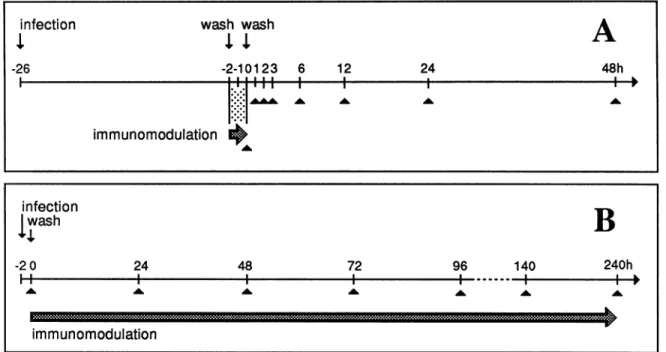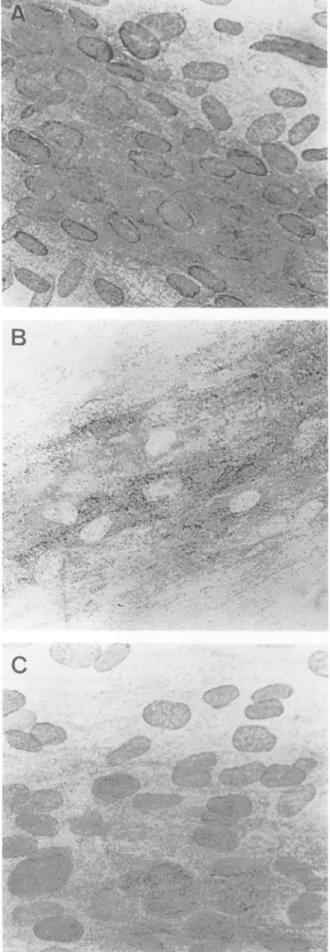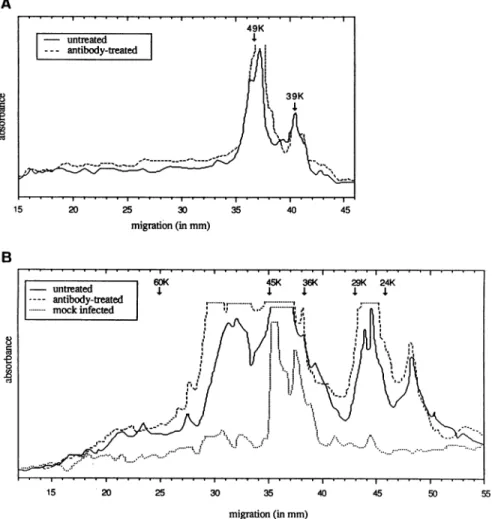OF p.7499-7504 0022-538X/92/127499-06$02.00/0
Copyright© 1992,American Societyfor Microbiology
Vol. 66,No. 12
NOTES
Antibodies
to
Varicella-Zoster Virus Modulate Antigen
Distribution but Fail To Induce Viral
Persistence
In
Vitro
CATHERINESADZOT-DELVAUX, PHILIPPE MARC, LINDA LEBON, MARIE-PAULEMERVILLE-LOUIS, JACQUESPIETTE,
ANDBERNARD RENTIER*
Fundamental Virology Unit, Departmentof MicrobiologyB23,
University
of
Liege,
4000 SartTilman,
Licge, Belgium
Received 23 March 1992/Accepted 28 August 1992Varicella-zoster vwirus (VZV) persists in human sensory ganglia. One of the hypotheses to explain the inductionorthe maintenance of VZVlatencyis thatit could be promoted by the immuneresponseitself. It is known that in thecaseofviruseswhichbud off the infectedcell membrane, virus-specific antibodiescaninduce antigenic modulation, i.e., spatial redistribution of viral antigens and modulation of their synthesis. To determine whetherantigenicmodulationoccursduring VZV infectionin vitro and couldpossiblybeinvolved
in viral persistence,wehavegrowninfectedcells in thepresenceof anti-VZV antibodies eithertransientlyor permanently. The distribution of immune complexes and viral proteins was then analyzed. In transient
immunomodulation experiments, thedistribution ofone or moreviral antigenswasmodifiednot onlyinthe cytoplasmic membranes but also in the cytoplasm and nucleoplasm of infectedcells.When infectedcellswere
kept permanently in thepresenceof antibodies, thesamepatternof redistribution ofimmune complexeswas
observed andthe localization ofinternal viral glycoproteinswassignificantlymodified. However, antibodies did
not prevent the ytic effect of infection; they altered neither the infectious virus yield nor the Western
immunoblot pattern ofviralproteins, suggesting that immunomodulation isnottheprimaryeffector of viral persistence.
Varicella-zoster virus (VZV) is a human herpesvirus
which causes a primary infection in childhood, becomes
latent in dorsal root ganglia, and can be reactivated many yearslatertoproduce shinglesinadults(10).Investigation of
mechanismsbywhichviruses becomepersistent andremain latent in infected cells progresses along two paths: (i)
searches foraviral gene that isdirectlyorindirectly respon-sible for latency and (ii) identification of host factors that
induce viral latency. In the latter case, the main factor of interest isthehost immune system. It has been shown that
bothinvitroand in
vivo,
persistence ofavirus which buds attheplasmamembrane ofinfected cellscanbe induced bythe presence of antiviral antibodies at the time of virus
maturation
(20-23).
Antibodytreatment caninduce aredis-tribution of membrane antigens which are assembled in patches and thenin caps, ashas been welldocumented for
enveloped viruses buddingattheplasma
membrane,
suchasmeasles virus (8, 9, 13,
18),
a retrovirus(19),
or influenza virus (24). Studies ofmeasles virus have demonstratedthatthe effect ofantibodies onthe viral
replication
cycle isnot restrictedto amechanical hindrance of thebuddingprocess. In fact, antibodies modulate through an unknown mecha-nismthesynthesis
ofthe viralglycoproteins
expressed
on the cell surface beforebudding (5-7, 14). Regulationof geneexpressionhas also been described foraparvovir'us
(1)
and a coronavirus(3).
Thephenomenon ofspecific regulation
of*Corresponding author.
gene expressionby antibodieswasfirstdescribed for cellular structuralproteins and calledimmunomodulation by
Stack-pole etal. (25). Such an immunomodulating effectonviral genetranscriptioncould lead to persistence (17) and could account, on amdlecularbasis,for the data obtained for the induction ofpersistence by antibodypressure.
At first sight, such a phenomenon may seem rather
un-likelyforvirusesof thefamilyHerpesviridae,sincetheyare
known to mature at the inner nuclear membrane and in
cytoplasmicvesicles. However, viralglycoproteins are
ex-pressed on the plasma membrane during infection. These
proteins do not participate in the
assembly
of the viralparticle,buttheyarefullyaccessible and can thus be targets forantiviral antibodies. During latency, highanti-VZV
anti-body
levels can be detected (2), but their role in theinductionormaintenance ofa quiescentstate is unknown.
Indeed,in thecaseofherpessimplexvirus
infection,
it isnotclear whether the
binding
ofimmunoglobulins
tovirus-inducedFc receptorsplays(4)ordoesnot
play
(11)
arole in the inhibition of virusgrowth. Even thoughourlaboratory
studies can only mimic the in vivo
situation,
it is worthcontrolling
the direct effect of antibodies on the course of viralinfection. We havethustestedthe immunomodulation hypothesis inorder to confirm it or to rule it out, at least under in vitro conditions.MRC-5 cells
(human embryonic
lung
fibroblasts;
Bi-om6rieux, Marcy I'Etoile,
France)
weremaintained inEa-gle's basal medium
(GIBCO
Laboratories,
GrandIsland,
N.Y.) supplemented with 10% fetal calf serum, 100 U of 7499by on November 25, 2009
jvi.asm.org
TABLE 1. Molecularweightsandidentities ofpolypeptides recognized bymonoclonalantibodies
Monoclonad Molwt
(1O3)
Identityantibody
Biosoft215-84/101 49 and 39 gpII
VL1 49and 39 gpII
VL8 70, 63, and 57 gpl
penicillin per ml, 100 mg ofstreptomycinperml, and0.15% NaHCO3.
The originalstrain of VZVusedinthisstudywas isolated by sterile aspiration of vesicular lesions of a patient with chicken pox. Restriction analysis of the purified DNA showed the typical pattern of VZV Ellen strain. Infection waspropagated by cocultivationofMRC-5cells with VZV-infected MRC-5 cells(ratioof 1infected cellto3 uninfected cells).
Human anti-VZVantibodies wereprepared by ammonium
sulfate precipitation of a non-convalescent-phase human
plasma with high anti-VZV antibody activity (>12,800 in enzyme immunoassay) and dialysis at 4° C in
phosphate-buffered saline(PBS).Anti-VZVrabbithyperimmuneserum was obtained by immunization with VZV purified from infected MRC-5 cells followedbythree steps ofabsorption
on uninfected cells to decrease reactivity against nonviral
antigens. Monoclonal antibodieswere either obtained from
Biosoft (Paris, France) (215-84/101) or produced in our
laboratory (VL1 and VL8). The molecular weights of the viralpolypeptides recognized by thesemonoclonal
antibod-iesarelisted in Table 1. Thespecificityof eachantiserumor monoclonal antibody was verified by immunohistology or Westernblotting (immunoblotting) analysisoninfected and uninfected cells.
MRC-5 cells infected bycocultivationwithVZV-infected
ormock-infected cells were treated with human anti-VZV
antibodies(1/20in cellculturemedium)eithertransiently (2
h) orpermanently(for72h) (Fig. 1).
Viral antigens were detected by surface immunolabeling
on cells fixed with 4%(wt/vol)paraformaldehyde in PBS (pH
7.6) (20 min at20° C). For intracellular labeling, cellswere
fixed in acetone for 5 min (-20° C), dried, and stored at
-20° C until use or fixed in paraformaldehyde, permeated
with95% ethanol(15min at -20° C),andstoredat4° C.Just before use,cellswererehydratedin PBS at 20° Cfor 5 min. Aftersaturationwith skimmed milk(15g/literinPBS)for 30 min at20° C,viralantigenswerelabeledbyincubation either with rabbit anti-VZVantibody(1:50inPBS, 60minat37° C)
orwith a monoclonalantibodyor ahumanplasmawithhigh anti-VZV antibody activity (1:40 in PBS, 60 min at 37° C).
After four washes with PBS, endogenous
peroxidase
was inactivated by a treatment with 0.03% (vol/vol) hydrogen peroxideinPBSfor 15 min. Then goat anti-rabbitimmuno-globulin (Ig), rabbit anti-mouse IgG, or rabbit anti-human IgG antibodycoupled to peroxidase (Dako, Glostrup,
Den-mark)(1:40inPBS, 60 min at37° C)wasadded. The presence ofperoxidasewasrevealedwith diaminobenzidine tetrachlo-ride (0.5 mg/ml in PBS) and 0.01% (vol/vol) hydrogen peroxide.
Viral antigens were analyzed by Western blotting (26).
They wereproducedfrominfected cellsbywashingthe cells several times with serum-freeculturemedium, mechanically scraping the cells off the plastic substrate in PBS, and
centrifugating the cells for 10 min at 400 x g. Thepellets corresponding to 75 cm2 of cells were then resuspended
either in 0.5 ml of RIPAmixture(12)orin thesamevolume
of PBS prior to ultrasonication for 1 min.
Finally,
the material was centrifuged at 200 x g for 15 min. Antigenswere treated 1:1 (vol/vol) in a denaturing mix (0.125 M
Tris-HCl [pH 6.8], 4%
[wtlvol]
sodium dodecyl sulfate[SDS], 20%
[vol/vol]
glycerol, 10%[vol/vol]
,B-mercaptoeth-anol, 5%[vol/vol]
bromophenolblue)
and then heated at 100° C for 90 s.Samples(3.75,ug ofproteins[16]ineachwell)infection
wash
wash
A-26 -2-10123 6 12 24 48h T.. III I I I A.&w&= ^ ^ ^ I
immunomodulation
infection
wash
B
-2 0 24 48 72 96 140 240hi11
l
IIonI I immunomodulationFIG. 1. Schematic representation of transient (A) and permanent (B) immunomodulation
corresponds to duration of antibody treatment. Arrowheads indicate times of sample fixation. treatment protocols. The thick arrow
by on November 25, 2009
jvi.asm.org
NOTES 7501
r-~
C
FIG. 2. Detection of antigen-antibody complexesonthesurface of VZV-infectedcellscultured with anti-VZV human antibodies for 2 h (transient immunomodulation). The complexes were detected by immunoperoxidase with a rabbit peroxidase-labeled anti-human Ig (Dako) oncells fixed 0(A),1(B),or3(C) h after immunomodulation treatment. Patches (arrows) and a cap (arrowhead) are indicated. Magnification, x240.
were applied onpolyacrylamide gels (4%
[wt/vol]
in 0.5 MTris-HCl [pH 6.8]for thestackinggels; 8%
[wt/vol]
in 1.5 MTris-HCl
[pH 8.8]
for the separating gels). Electrophoresiswas run at 150 V in0.025 M Tris (pH
8.3)-0.2
M glycine-0.1% (wt/vol) SDS. Proteins were transferred onto anIm-mobilon membrane
(Millipore)
in aBiolyondry electroblot-teraccording
the manufacturer's instructions(1
h at24V).
Transient immunomodulation experiments were per-formed to verify whether antibodies could bind to viral
antigensonlivingcells and could thusinduce modifications
of viralexpression.Humananti-VZVantibodieswereadded tothe culture medium24hafter
infection,
maintainedfor2h, and then removed (Fig. 1A). Mock-infected cells were
cultured and treated in the same way. The fate of antigen-antibodycomplexeswasmonitored.Whencultured infected
cells wereexposedtoantibodies specific of their membrane
constituents,
the immune complexes formed either were internalized (15) or remained on the cell membrane (20).When cellswere fixedatvarious times after immunomodu-lation and then incubated with rabbit anti-human IgG
anti-bodies coupledtoperoxidase
(Dako)
(1/40 in PBS,60 minat37° C),
immunecomplexes
were neverdetected onthe sur-faceof uninfectedcells, and atypicalpatching
andcapping
effect was observed on infected cells. The presence of membranous
antigen-antibody complexes
formedduring
theimmunomodulation treatment was observed
by using
ala-1 4w . It TO 0 " 1. .@. .M5,, Ir:4,I-,. I - X,.'. 'S. fa by on November 25, 2009 jvi.asm.org Downloaded from
FIG. 3. Immunoperoxidase labeling of viral antigen with a mono-clonal antibody (Biosoft 215-84/101) on VZV-infected cells. Cells were cultured without (A) or with (B and C) anti-VZV human antibodies for 2h, rinsed, and then fixed with acetoneimmediately (B)orafter 1 h(C).Magnification, x440.
beled anti-human Ig antibody. Such complexes were homo-geneously distributed on the cell surface immediately after antibody treatment (Fig. 2A). If cells were allowed to recoverafter treatment, immune complexes formed patches randomly scatteredon the surface (Fig. 2B) and then
gath-ered in a cap (Fig. 2C). Endocytosis followed; no labeling was detected after paraformaldehydefixation, whereas
cy-toplasmic labelingwas observed after acetonefixation,after which there was almost complete clearance of complexes
from the cells.
Theeffect ofantibodytreatmentwassignificant whenfree
antigenic sites were observed byimmunoperoxidase
label-ing. The moststriking observationwasthe profound modi-ficationof the localization of viralepitopes recognizedbyan
anti-gpIImonoclonalantibody afterthetransienttreatment. Inuntreatedcells,anepitopewith anuclear andcytoplasmic
distribution was observed (Fig. 3A). This distribution be-cameexclusively cytoplasmic when cells were cultured for 2 h in the presence of anti-VZV antibodies (Fig. 3B). When
antibodies were washed away, it took only 60min for the
epitope localizationtobecome nuclearagain (Fig.3C). This modificationof viralepitope localizationwasconfirmed with
ananti-gpI monoclonalantibody.
However, viral proteinexpressionwas unchanged quali-tatively and perhaps only slightly delayed by transient
immunomodulation; the anti-gpIImonoclonal antibodies re-vealed two major bands (49 and 39 kDa) in Western blot
analysis of VZV-infected MRC-5 cells, even in untreated
cells and cells transiently treated with human anti-VZV antibodies(Fig. 4). In the same way, nomodificationof the expression of viralproteins recognized by rabbit anti-VZV
hyperimmune serumhas beendetected.
Thesetransientimmunomodulationexperimentsindicated that underthe conditions described, antibodiesreactedwith
luntreated 1 49K 39K
I--antibody-treatedlI
S~ ~
~~~1
15 20 25 30 35 40 45
migration(in mm)
FIG. 4. Electrophoretic profile of viral antigens revealed after Western blotting. Cells were cultured without or with anti-VZV
human antibodiesduring2 h and recovered 48 hafter infection. Viral polypeptidesweredetected withananti-gpIImonoclonalantibody.
C
.~A . ;:A f. '.. I.. #'L::'Vols,k M'. 1'.. ... .... ... ... .... 4. A" W ll.Ea 4i, by on November 25, 2009 jvi.asm.org Downloaded fromNOTES 7503 A 8 0
AL
15 20 25 30 35 40 45 migration(in mm) B 8 .0 15 20 25 30 35 40 45 50 55 migration(inmm)FIG. 5. Electrophoretic profile of viral antigens revealed after Western blotting. Cells were cultured without or with anti-VZV human antibodiesduring48hand then recovered. Viralpolypeptides were detected withananti-gpII monoclonal antibody (A) or a rabbit anti-VZV hyperimmuneserum(B).
viral antigens on infected cells in such a manner that they
could inducesignificant modificationsin these cells. Perma-nent immunomodulation experiments could then be
under-taken. Infected andmock-infected cellswerecultured in the presence of human anti-VZV antibodies for various times
and thenfixed (Fig. 1B). The effectsofimmunomodulation
werestudiedby searchingfor immune complexes on the cell surface,modificationsof localization andexpressionof viral
polypeptides, andproductionofinfectiousvirus. The same
pattern of redistribution of immune complexes on the cell surfacewasobserved, andmodifications of thelocalization
of internal viralglycoproteins occurredasin transient treat-ment.
Expression
of viralpolypeptides after 48 h of culture in the presence of anti-VZV antibodies was qualitatively unmodified, asindicated byWestern blotting analysiswithTABLE 2. Infectivity after permanent immunomodulation
Antibody Duration(h)of Infectivity
treatment immunomodulation (PFU/106cells)
1,670
+ 48 1,500
6,300
+ 72 8,000
an anti-gpII monoclonal antibody (Fig. SA) or with rabbit anti-VZV antibodies(Fig. SB). Anyquantitative differences
thatappearedseemedtoreflectvariations in theevolutionof
infectionin cell cultures.
Treated and untreated cells were scraped, pelleted, and
ultrasonicated. Supernatantswereinoculatedon uninfected
MRC-5
cells,and fociwerecounted after4 days. Infectious titers remained unchanged and evolved similarly whether cellshad been treatedornot(Table 2).Our data indicate that antibody treatment of infected
MRC-5
cells,although playing
adramaticrole in the intrac-ellularlocalization of viralglycoproteins, has,surprisingly,
noapparent effectonviral maturation and assembly. Since
polypeptides present at the cell surface and capable of
interacting with antibodies during immunomodulation treat-ment areglycoproteins,weusedantiglycoproteinantibodies for characterization of the immunomodulation effects. How-ever, it remains possible that a change in expression or
localization of nonglycosylated polypeptides occurs in re-sponse to antibody pressure, but in this case, it does not seem to alter production of infectious
particules.
Such an immunomodulation treatment is thus obviously unable to induce persistent VZV infection in vitro. The correlation betweenthe permanent presence of anti-VZVantibodies inbody fluids during the latent
phase
of infection and theVOL.66, 1992
by on November 25, 2009
jvi.asm.org
induction of a quiescent state is thus weakened by our observations. However, ourfindings do notexclude a role for humoral immunity in maintaining VZV latency once it hasbeen induced.
While performing this work, P.M. and L.L. were grantees of IRSIA; C.S.-D., M.-P.M.-L., and J.P. are, respectively,aresearch assistant,a researchassociate, andaseniorresearch associateofthe NationalFund forScientific Research, Brussels, Belgium.Wethank the NFSR, FMRS, and National Lottery of Belgium for financial support.
REFERENCES
1. Alexandersen, S., S. Larsen, A. Cohn, A. Uttenthal, R. E. Race, B.Aasted, M. Hansen,and M. E.Bloom. 1989. Passivetransfer of antiviral antibodies restricts replication of Aleutian mink disease parvovirusin vivo. J.Virol. 63:9-17.
2. Brunell, P. A., A. A. Gershon, W.T. Hughes, H. D. Riley, Jr., and J.Smith. 1972.Prevention of varicellainhighriskchildren: acollaborative study. Pediatrics50:718-722.
3. Buchmeier, M. J., H. A. Lewicki, P. J. Talbot, and R. L. Knobler. 1984. Murine hepatitis virus-4 (strain JHM)-induced neurologic diseaseismodulatedinvivoby monoclonal antibod-ies. Virology 132:261-270.
4. Costa, J., A. S. Rabson, C. Yee, and T. S. Tralka. 1977. Immunoglobulin binding to herpes virus-induced Fc receptor inhibits virus growth. Nature (London) 269:251-252.
5. Fujinami, R. S., E. Norrby, and M. B. A. Oldstone. 1984. Antigen modulation induced by monoclonal antibodies: antibod-ies to measles virus hemagglutinin alters expression of other viralpolypeptides in infected cells.J.Immunol. 132:2618-2621. 6. Fujinami,R.S.,and M. B. A.Oldstone.1979.Antiviral antibody reactingon theplasmamembranealters measlesvirus expres-sioninside the cell. Nature(London) 279:529-530.
7. Fujinami, R. S., andM. B. A. Oldstone. 1980. Alterations in expressionof measles virus polypeptides by antibody: molecu-lar events in antibody-induced antigenic modulation. J. Immu-nol. 125:78-85.
8. Gould, J. J.,andJ.D. Almeida.1977.Antibody modification of measles in vitro infection. J. Med. Virol. 1:111-117.
9. Hooghe-Peters,E. L., B. Rentier,and M.Dubois-Dalcq. 1979. Electron microscopic study of measles virus infection: unusual antibody-triggered redistribution of antigens on giant cells. J. Virol.29:666-676.
10. Hope-Simpson,E.R.1965. The natureof herpes-zoster: a long termstudy anda newhypothesis. Proc. R.Soc. Med. 58:9-20. 11. Johanson, P.J. H., and L. Kjellen. 1988. Inhibition of herpes simplex virus growth caused by preparations of animal immu-noglobulins is not dependent onFc-Fc receptor interactions. Intervirology29:334-338.
12. Lamb,R.A.,P. R.Etkind,and P.W.Choppin. 1978.Evidence foraninthinfluenza viral polypeptide. Virology 91:60-64.
13. Lampert, P.W., B. S. Joseph, andM. B. A.Oldstone. 1975. Antibody-induced capping of measles virus antigensonplasma membrane studied by electron microscopy. J. Virol. 15:1248-1255.
14. Liebert, U. G., S. Schneider-Schaulies, K. Baczko, and V. ter
Meulen. 1990. Antibody-induced restriction of viral gene expression in measles encephalitis inrats.J.Virol. 64:706-713. 15. Loor, F. 1977. Structure and dynamics of the lymphocyte surface, in relationtodifferentiation, recognition and activation. Prog. Allergy23:1-153.
16. Lowry,0.H., N. J. Rosebrough, A. L. Farr, and R. J.Randall. 1951. ProteinmeasurementwithFolin phenol reagent. J. Biol. Chem. 193:265-269.
17. Oldstone,M. B.A., R. S.Fujinami, and P. W. Lampert. 1980. Membrane and cytoplasmic changes in virus-infected cells in-duced by interaction of antiviral antibody with surface viral antigen. Prog. Med. Virol. 26:45-93.
18. Oldstone, M.B.A., and A. Tishon. 1978. Immunologic injury in measlesvirus infection. IV.Antigenicmodulation and abroga-tion oflymphocyte lysis of virus-infected cells. Clin. Immunol. Immunopathol. 9:55-62.
19. Phillips, E. R., and J. F. Perdue. 1976. The dynamics of antibody-induced redistribution of viral envelope antigens in the plasmamembranes of aviantumorvirus-infected chick embryo fibroblasts. J. Cell Sci. 20:459-477.
20. Rammohan, K. W., M. Dubois-Dalcq, B. Rentier, and J. Paul. 1983.Experimental models to study measles virus persistence in thenervoussystem.Prog. Neuropathol. 5:113-137.
21. Rammohan, K. W.,D. E.McFarlin, andH. F.McFarland. 1981. Induction of subacute murine measles encephalitis by monoclo-nalantibodytovirushaemagglutinin.Nature(London) 290:588-589.
22. Rammohan,KW.,D. E.McFarlin,and H. F.McFarland.1982. Subacutesclerosing panencephalitis after passive immunization and natural measles infection: role of antibody in persistence of measles virus. Neurology 32:390-394.
23. Rustigian, R. 1966. Persistent infection of cells in culture by measles virus. II. Effect of measles antibody on persistently infected HeLa sublines and recovery of a HeLa clonal line persistently infected with incomplete virus. J. Bacteriol. 92: 1805-1810.
24. Rutter,G.,and K.Mannweiler.1976. Antibody-induced redis-tribution of virus antigens on the surface of influenza virus-infected cells.J. Gen. Virol. 33:321-332.
25. Stackpole, C. W., J. B. Jacobson, and M. P. Landis. 1974. Antigenic modulation in vitro.I.Fate ofthymus-leukemia (TL) antigen-antibody complexes following modulation of TL antige-nicity from the surfaces ofmouse leukemia cells and thymo-cytes. J.Exp. Med. 140:939-953.
26. Towbin, H.,T. Staehelin, and J. Gordon. 1979. Electrophoretic transfer of proteins frompolyacrylamidegels to nitrocellulose sheets: procedure andsomeapplications. Proc. Natl. Acad. Sci. USA 76:4350-4354.
by on November 25, 2009
jvi.asm.org



